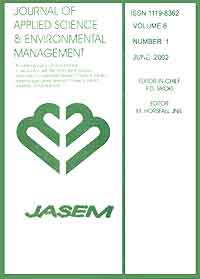
|
Journal of Applied Sciences and Environmental Management
World Bank assisted National Agricultural Research Project (NARP) - University of Port Harcourt
ISSN: 1119-8362
Vol. 20, No. 4, 2016, pp. 1113-1117
|
 Bioline Code: ja16120
Bioline Code: ja16120
Full paper language: English
Document type: Research Article
Document available free of charge
|
|
|
Journal of Applied Sciences and Environmental Management, Vol. 20, No. 4, 2016, pp. 1113-1117
| en |
Evaluation of the Physico-Chemical Properties of Produced Water from Oil Producing Well in the Niger Delta Area, Nigeria
CHIKWE, T.N. & OKWA, F.A.
Abstract
Physicochemical properties of produced water from oil producing well were conducted using
standard methods (American standard for testing and materials). Samples were obtained at different periods within two
months. Produced water comprises approximately 98% of the total volume of exploration and production (E&P) waste
generated by the oil and gas industry. Results obtained; pH (7.90-8.10), total oil and grease (27.00-37.00mg/l), sulphate
(45.00-75.00mg/l), total petroleum hydrocarbon (12.00-14.00 mg/l), electrical conductivity (26100.00-26600.00μs/cm),
total dissolved solid (16750.00-17100.00mg/l); salinity (22801.00 – 23403mg/l) show that all the measured parameters
were within specification as recommended by Department of Petroleum Resources (DPR). TOG of produced water
receives the most attention in both offshore and onshore locations while salt content (electrical conductivity, salinity and
total dissolved solids) receive more attention in onshore locations. TOG and TPH above permissible limit (40 mg/l and
20 mg/l respectively) reduces the biochemical oxygen demand in the sea which is detrimental to the survival of aquatic
life. Maintaining sulphate concentration within acceptable limit prevents scale formation by calcium and barium ions.
Volume of water produced increases with the age of Crude oil production.
Keywords
Physicochemical; toxicity; reservoir; aquatic; offshore; benthic
|
| |
© Copyright 2016 - Journal of Applied Sciences and Environmental Management
|
|
